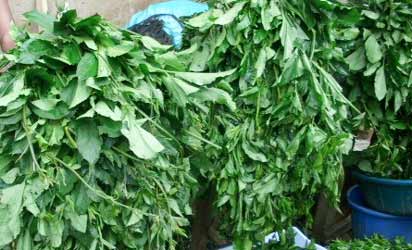Telfairia occidentalis,is popularly known as ugu in igbo, iroko in Yoruba, and ubong in Efik. Other common names for the plant include fluted gourd and fluted pumpkin. Telfairia occidentalis is a tropical vine grown in West Africa as a leaf vegetable for its edible seeds. Lately the popularity has spanned across other ethnic groups, thereby taking the medicinal and commercial value of the vegetable to a higher level.
Though endemic to southeastern Nigeria, Telfairia is of local ethno-botanical importance in the folklore and the dietary and cropping systems of Igbos and their neighbours. Telfairia has long been important in the internal food trade of Igbos. Like other leaf vegetables, it is of low commercial value but, in some cases, can provide an appreciable cash income to small farm families. Its leaves, succulent shoots, and seed kernels, constitute the usual ingredients that are popular and regularly consumed in Igbo soups. Soups made of leaf vegetables are essential for consumption of starchy pastes of yam, cassava, or cocoyam, which are frequently consumed in the humid areas of Nigeria. Many good attributes account for the increasing importance of this chief vegetable among 30 to 35 million people in Nigeria.
The plant is a drought-tolerant, dioecious perennial that is usually grown trellised. The young shoots and leaves of the female plant are the main ingredients of a Nigerian soup, edikang ikong. The large (up to 5 cm), dark-red seed is rich in fat and protein, and can be eaten whole, ground into powder for another kind of soup, or made into a fermented porridge.
The fruit of the plant is large, weighing up to 13 kg, but it is inedible.
Research Findings
Telfairia occidentalis is known to contribute in blood building. Studies have shown cases of patients who resorted to the use of this this vegetable in place of blood tonics gaining sufficient blood level in three weeks. In empirical terms, about 90% of the blood can be built. It has also been found out that it has no negative side effect either on the long and short term. Experts have attributed the increase in its use to a number of factors: poverty level, high cost of medicines.
Nutritional Content
This blood-building vegetable is known to contain protein, carbohydrate, fat, calcium, iron, magnesium, potassium, calcium, and vitamin such as A, B2, B5, B12 and thiamine. With a wide array of B vitamins, and the presence of vitamin A for good vision, the therapeutic and health maintaining qualities are well show cased.
Nutritional Value
Younger pumpkin seeds may be nutritionally preferred for consumption since they contain less anti-nutrients than older seeds. However, mature pumpkin seeds contain high potassium, iron and crude fat (56.24%) and hence could be further developed to increase world vegetable oil production.
TOLM (Telfairia occidentalis leaf meal) in broiler starter diets may be nutritionally beneficial in poultry feeding and subsequently reduce the use of the expensive animal protein sources in practical feed formulation.
Culinary value: Scientifically, this vegetable is use as a herbal remedy for anaemic conditions. Liquid extracts from the fresh leaves is consumed as juice.
In general, it is a good and healthy habit to practice eating vegetables. The vegetarian plant-based diet typically has the advantage of being low in saturated fat, cholesterol, and salt. The Pyramid Food Guide published by the Department of Agriculture helps show all nutritional requirements. At the bottom of the pyramid are the grains, vegetables, and fruits that are recommended to form the foundation of a healthful diet. In the middle of the pyramid are foods from the milk group and the meat and beans group, which are prescribed in moderate amounts. At the top of the pyramid are high-fat and sugary foods, indicating that they should be eaten in small amounts or avoided altogether.
Health is wealth, so eat healthy!
BY Eru Kobe Godwin

